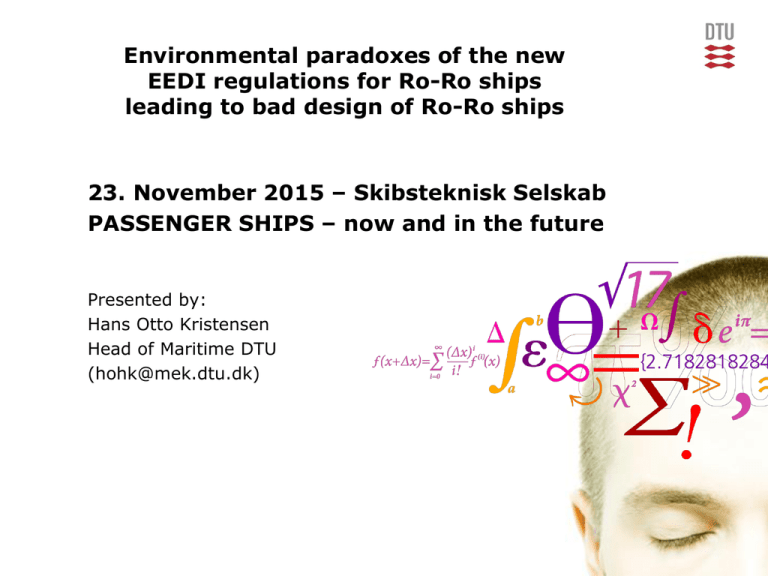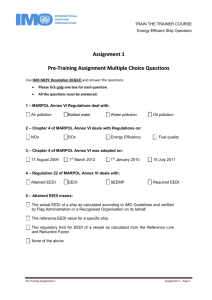Document
advertisement

Environmental paradoxes of the new EEDI regulations for Ro-Ro ships leading to bad design of Ro-Ro ships 23. November 2015 – Skibsteknisk Selskab PASSENGER SHIPS – now and in the future Presented by: Hans Otto Kristensen Head of Maritime DTU (hohk@mek.dtu.dk) Content of the presentation •Fundamentals of the EEDI calculation procedure for Ro-Ro ships (rules and regulations) •Technical fundamentals of Ro-Ro passenger ships •Calculation example of a 1600 passenger Ro-Pax ship •Calculation example of a 400 passenger Ro-Pax ship •Summary of example calculations •Conclusions 2 Technical University of Denmark The EEDI formulas (excl. equations for alternative propulsion means such as wind, solar power etc.) MEPC 245(66) – 4. April 2014 For Ro-Ro cargo ships and Ro-Ro passenger ships: Capacity is the maximum permissible deadweight For passenger ships and cruise passenger ships: Capacity is the Gross Tonnage (GT) in accordance with the internatinal Convention of Tonnage Measurement of Ships 1969, Annex 1, Reg. 3 3 Technical University of Denmark EEDI according to MARPOL Annex 6, Reg. 21 Attained EEDI <= Required EEDI x (1 – R) Required EEDI: Ro-Ro passenger ships: 752.16 x DWT-0.351 Ro-Ro cargo ships: 1405.15 x DWT-0.498 DWT is the maximum permissible deadweight at summer load draught R depends on the keel laying date 4 Technical University of Denmark Reduction factor R in percent for Ro-Ro ships EEDI = (1 – R/100) ∙ EEDI baseline value Ship type Phase 0 Phase 1 Phase 2 1. Jan. 2013 1. Jan. 2015 1 Jan. 2020 31. Dec. 2014 31. Dec. 2019 31. Dec. 2024 >1000 tons n/a 5 20 30 250 – 1000 tons n/a 0–5 0 – 20 0 – 30 >2000 tons n/a 5 30 30 1000 – 2000 tons n/a 0–5 0 – 20 0 – 30 Deadweight Phase 3 1 Jan. 2025 Ro-Ro passenger Ro-Ro cargo 5 Technical University of Denmark 100 EEDI requirements for Ro-Pax ships 90 80 EEDI baseline = 752.16 x DWT^(-0.381) EEDI (g/t/nm) 70 1. September 2015 60 1. January 2020 50 1. January 2025 40 30 20 10 0 0 1000 2000 3000 4000 5000 6000 Deadweight (t) 6 Technical University of Denmark 7000 8000 9000 10000 Ro-Pax ships Design service speed versus EEDI ref. speed EEDI reference speed (knots) 22 Ro-Pax ship with 1600 pass. Design condition: 15 % resistance margin and 90 % MCR loading 20 18 16 14 12 10 10 12 14 16 Design speed (knots) 7 Technical University of Denmark 18 20 22 Auxiliary power for Ro-Ro cargo ships according to MEPC 245(66) Main engine power (PME) less than 10000 kW: PAE = 0.05 x PME Main engine power (PME) more than 10000 kW: PAE = 250 + 0.025 x PME Reg. 2.5.6.4: For ships where the PAE value calculated by the above mentioned formulas is significantly different from the total power used at normal seagoing condition, the PAE value should be estimated by the consumed electric power (excluding propulsion) in conditions when the ship is engaged in a voyage at reference speed. 8 Technical University of Denmark Auxiliary power for Ro-Ro pass. ships for ref. line calculations according to MEPC 65/22 Annex 14, p. 3 Aux. power at sea = 0.35 x installed aux. power Auxiliary power at sea = 0.866 x GT0.732 12000 ShipPax aux- power data 1600 pass. Ro-Pax acc. to EEDI regulations Total aux. power (kW) 10000 400 pass. Ro-Pax acc. to EEDI regulations Aux. power for ref.line calculations (MEPC 65) y = 2.4729x 0.732 Potens (ShipPax aux- power data) 8000 6000 4000 2000 Installed aux. power according to ShipPax database (2012) 0 0 10000 20000 30000 40000 50000 Gross tonnage (GT) 9 Technical University of Denmark 60000 70000 80000 Auxiliary power for Ro-Ro cargo ships according to MEPC 245(66) 90 Auxiliary power in pct. of main engine power 80 1600 pers. Ro-Pax ship 70 60 50 40 30 20 10 0 10 12 14 16 Design speed (knots) 10 Technical University of Denmark 18 20 22 fj correction factor for Ro-Ro ships MEPC .245(66) – Annex 5 – Reg. 2.8.3 11 Technical University of Denmark fc correction factor for Ro-Ro ships MEPC .245(66) – Annex 5 – Reg. 2.12.3 12 Technical University of Denmark EEDI fj and fc correction factors for Ro-Pax EEDI correction factors fj and fc 1.4 1.2 fj Ro-Ro pass. 1.0 fc Ro-Ro pass. 0.8 0.6 Ro-Pax ship (1600 passengers) 0.4 0.2 0.0 10 13 12 Technical University of Denmark 14 16 18 Design speed (knots) 20 22 Low and high cargo density Ro-pax ships (Deadweight per passenger) Deadweighpt per passenger (t/pass.) 40 Ships with low cargo density Ships with high cargo density Ro-Pax limit (1.5 LM and 6 t dw per passenger) Potens (Ships with high cargo density) Potens (Ships with low cargo density) 35 30 25 Dw/pass. = 849 pass.-0.689 20 Ro-Ro passenger ships 15 Dw/pass. = 62.4 pass.-0.448 10 5 0 0 400 800 1200 1600 Passengers 14 Technical University of Denmark 2000 2400 2800 3200 Low and high cargo density Ro-pax ships (Lanemeter per passenger) 14 Lanemeter per passenger (m/pass.) Ships with low cargo density 12 Ships with high cargo density LM = 72.9 pass. 10 Cargo limit line (1.5 LM and 6 t dw per passenger) -0.505 Potens (Ships with high cargo density) Potens (Ships with low cargo density) 8 Ro-Ro passenger ships 6 4 LM = 37.5 pass.-0.551 2 0 0 400 800 1200 1600 Passengers 15 Technical University of Denmark 2000 2400 2800 3200 Low and high cargo density Ro-pax ships (Lpp as function of passenger capacity) 240 Lpp = 81.4 pass. 0.113 Length pp (m) 200 160 120 Ships with low cargo density Ships with high cargo density DFDS ships with low cargo density DFDS ships with high cargo density Potens (Ships with high cargo density) Potens (Ships with low cargo density) 80 Lpp = 22.5 pass.0.255 40 Ro-Ro passenger ships 0 0 400 800 1200 1600 Passengers 16 Technical University of Denmark 2000 2400 2800 3200 Typical low cargo density Ro-pax ship (Pearl Seaways) 17 Technical University of Denmark Typical high cargo density Ro-pax ship (Regina Seaways) 18 Technical University of Denmark Ro-Pax ships Empirical calculation of gross tonnage GT 3.0 Ro-Ro passenger ships Ships with high cargo density 2.6 GT/t displacement Ships with low cargo density Lineær (Ships with high cargo density) 2.2 GT/displ. = 0.0000156 displ. + 1.16 Lineær (Ships with low cargo density) GT/displ. = 0.0000352 displ. + 1.14 1.8 1.4 1.0 0 5000 10000 15000 Displacement (t) 19 Technical University of Denmark 20000 25000 30000 Ro-Pax ships Empirical calculation of gross tonnage GT 64000 Ro-Ro passenger ships 56000 Calculated GT 48000 40000 32000 24000 16000 8000 0 0 8000 16000 24000 32000 Real gross tonnage (GT) 20 Technical University of Denmark 40000 48000 56000 EXAMPLE No. 1 1600 passenger Ro-Pax ship with low cargo capacity Main dimensions Capacity Length between pp Breadth Maximum draught Depth to upper deck Length of Ro-Ro lanes Number of passenger cars Number of berths Normal deadweight Lightship weight Normal displacement Block coefficient based on Lpp Gross tonnage Normal service speed Engine power (MCR) Service speed obtained at 90 % MCR incl. 15 % sea margin 1600 pass. 147.65 m 24.63 m 5.89 m 14.32 m 1197 m 420 766 (48 % of pass.) 4160 tons (3.5 t/lm) 9172 tons 13332 tons 0.607 21455 GT 21.5 knots 18910 kW Main dimensions are calculated by the generic model SHIP-DESMO-RoPax developed by Hans Otto Kristensen (HOK Marineconsult ApS) as contractual work for DTU Transport 21 Technical University of Denmark Ro-Pax ship with 1600 passengers Full deadweight 35 250 30 25 150 20 15 100 Actual EEDI value EEDI base line - 2013 EDDI requirement in 2015 EEDI requirement in 2020 EEDI requirement in 2025 CO2 per ton payload per nm 10 Ro-Pax ship - 1600 pass. 4160 ton deadweight Payload: 2.1 t/lanemeter 5 50 0 0 10 12 14 16 18 Design speed (knots) 22 Technical University of Denmark 20 22 (g/t payload/nm) EEDI (g/t/nm) 200 Ro-Pax ship with 1600 passengers Full deadweight – Auxiliary power based on GT 40 250 35 220 EEDI (g/t/nm) 160 25 130 20 100 15 10 Ro-Pax ship - 1600 pass. 4160 t deadweight Aux. power based on GT 5 Actual EEDI value EEDI base line - 2013 EDDI requirement in 2015 EEDI requirement in 2020 EEDI requirement in 2025 CO2 per ton payload per nm 70 40 10 0 -20 10 23 12 Technical University of Denmark 14 16 18 Design speed (knots) 20 22 (g/t payload/nm) 190 30 Ro-Pax ship with 1600 passengers EEDI as function of deadweight 45 Ro-Pax ships 40 EEDI (g/t/nm) 35 30 25 20 EEDI required in 2015 15 EEDI required in 2020 10 EEDI required in 2025 5 EEDI baseline with 3 different different deadweights 0 2000 2400 2800 3200 Deadweight (t) 24 Technical University of Denmark 3600 4000 4400 Ro-Pax ship with 1600 passengers 20000 Ro-Pax ship (1600 pass.) Propulsion power (kW) 16000 Normal deadweight 4160 tons 25 % deadweight reduction (3120 t dw) 12000 50 % deadweight reduction (2080 t dw) 8000 4000 0 10 25 12 Technical University of Denmark 14 16 Speed (knots) 18 20 22 40 280 35 240 EEDI (g/t/nm) 30 200 25 160 20 120 15 10 Ro-Pax ship - 1600 pass. 3120 t deadweight Payload: 1.6 t/lanemeter 5 Actual EEDI value EEDI base line - 2013 EDDI requirement in 2015 EEDI requirement in 2020 EEDI requirement in 2025 CO2 per ton payload per nm 80 40 0 0 10 26 12 Technical University of Denmark 14 16 18 Design speed (knots) 20 22 (g/t payload/nm) Ro-Pax ship with 1600 passengers 25 % dw reduction Ro-Pax ship with 1600 passengers 50% dw reduction 350 45 40 300 250 30 25 200 20 150 15 10 Ro-Pax ship - 1600 pass. 2080 t deadweight Payload: 1.1 t/lanemeter 5 Actual EEDI value EEDI base line - 2013 EDDI requirement in 2015 EEDI requirement in 2020 EEDI requirement in 2025 CO2 per ton payload per nm 100 50 0 0 10 27 12 Technical University of Denmark 14 16 18 Design speed (knots) 20 22 (g/t payload/nm) EEDI (g/t/nm) 35 Ro-Pax ship with 1600 passengers EEDI values at different design speeds and deadweight 35 EEDI (g/t/nm) 30 25 Ro-Pax ship - 1600 pass. 20 15 EEDI value at 4160 t deadweight 10 EEDI value at 3120 t deadweight 5 EEDI value at 2080 t deadweight 0 10 28 12 Technical University of Denmark 14 16 18 Design speed (knots) 20 22 Ro-Pax ship with 1600 passengers Speed exponent, N, as function of speed and block coefficient, Cb 6 Ro-Pax ship 1600 passengers Power = constant x speedN EEDI = constant x speedN-3.5 Power exponent, N 5 4 3 N = 3.5 2 4160 t deadweight (Cb = 0.61) 3160 t deadweight (Cb = 0.56) 1 2080 t deadweight (Cb = 0.51) 0 10 29 12 Technical University of Denmark 14 16 18 Design speed (knots) 20 22 Ro-Pax ship with 1600 passengers CO2 per ton payload per nm at different design speeds and deadweight CO2 per t payload per nm (g/t/nm) 350 4160 t deadeweight 300 3120 t deadweight 250 2060 t deadweight 200 150 100 Ro-Pax ship - 1600 pass. 50 0 10 30 12 Technical University of Denmark 18 16 14 Design speed (knots) 20 22 Ro-Pax ship with 1600 passengers Variation of gross tonnage 40 35 EEDI (g/t/nm) 30 25 20 EEDI value at normal GT EEDI value at 20 % increase of GT 15 EEDI value at 20 % decrease of GT Ro-Pax ship - 1600 pass. Low cargo density 4160 t deadweight Change of gross tonnage 10 5 EEDI base line 2013 EEDI requrement in 2015 EEDI requirement in 2020 EEDI requirement in 2025 0 12 31 14 Technical University of Denmark 16 18 Design speed (knots) 20 22 Ro-Pax ship with 1600 passengers Variation of gross tonnage and light weight 35 EEDI (g/t/nm) 30 25 20 Ro-Pax ship - 1600 pass. Low cargo density 4160 t deadweight. Change of gross tonnage and lightweight 15 EEDI EEDI EEDI EEDI EEDI EEDI EEDI 10 5 value at normal GT value at 20 % increase of GT and 10 % lightweight increase value at 20 % decrease of GT and 10 % lightweight reduction base line 2013 requrement in 2015 requirement in 2020 requirement in 2025 0 12 32 14 Technical University of Denmark 16 18 Design speed (knots) 20 22 Ro-Pax ship with 1600 passengers Variation of gross tonnage and light weight 40 Ro-Pax ship - 1600 pass. Low cargo density 4160 t deadweight. Change of gross tonnage and lightweight 35 EEDI (g/t/nm) 30 25 20 EEDI EEDI EEDI EEDI EEDI EEDI EEDI 15 10 5 value at normal GT value at 20 % increase of GT and 20 % lightweight increase value at 20 % decrease of GT and 20 % lightweight reduction base line 2013 requrement in 2015 requirement in 2020 requirement in 2025 0 12 33 14 Technical University of Denmark 16 18 Design speed (knots) 20 22 Ro-Pax ship with 1600 passengers Variation of gross tonnage and light weight CO2 per t payload per nm (g/t/nm) 350 Original deadweight 300 20 % GT increase and 20 % lightweight increase 250 20 % GT reduction and 20 % lightweight reduction Ro-Pax ship - 1600 pass. Low cargo density. 4160 t deadweight Change of GT and lightweight 200 150 100 50 0 10 34 12 Technical University of Denmark 14 16 18 Design speed (knots) 20 22 Ro-Pax ship with 1600 passengers Variation of gross tonnage and light weight 8 Ro-Pax ship 2000 passengers Low cargo density. 4160 t deadweight GT and lightweight change Power = constant x speed N EEDI = constant x speedN-3.5 Power exponent, N 7 6 5 4 3 Original deadweight 2 20 % GT increase and 20 % lightweight increase 1 20 % GT reduction and 20 % lightweight reduction 0 10 35 12 Technical University of Denmark 14 16 18 Design speed (knots) 20 22 35 160 30 140 120 25 100 20 80 15 60 10 Actual EEDI value EEDI base line - 2013 EDDI requirement in 2015 EEDI requirement in 2020 EEDI requirement in 2025 CO2 per ton payload per nm Ro-Pax ship - 1600 pass. 4160 ton deadweight Payload: 2.1 t/lanemeter DUAL FUEL MAIN ENGINE 5 40 20 0 0 10 12 14 16 18 Design speed (knots) 36 Technical University of Denmark 20 22 (g/t payload/nm) EEDI (g/t/nm) Ro-Pax ship with 1600 passengers Full deadweight – DUAL FUEL main engine Ro-Pax ship with 1600 passengers Change of length 20000 Ro-Pax ship (1600 pass.) 4160 tons deadweight Change of length Propulsion power (kW) 16000 Normal Lpp = 147.65 m 10 % length increase 20 % length increase 12000 8000 4000 0 10 37 12 Technical University of Denmark 14 16 Speed (knots) 18 20 22 Ro-Pax ship with 1600 passengers Change of length CO2 per t payload per nm (g/t/nm) 250 Original Lpp = 147.65 m 200 10 % length increase 20 % length increase 150 100 Ro-Pax ship - 1600 pass. 50 0 10 38 12 Technical University of Denmark 14 16 18 Design speed (knots) 20 22 Ro-Pax ship with 1600 passengers Change of length 35 EEDI (g/t/nm) 30 25 20 EEDI EEDI EEDI EEDI EEDI EEDI EEDI 15 10 5 value at normal length value at 10 % length increase value at 20 % length increase base line 2013 requirement in 2015 requirement in 2020 requirement in 2025 Ro-Pax ship 1600 pass. 4160 DWT 0 10 39 12 Technical University of Denmark 14 16 18 Design speed (knots) 20 22 Ro-Pax ship with 1600 passengers Change of length 6 Ro-Pax ship 1600 passengers Power = constant x speedN EEDI = constant x speedN-3.5 Power exponent, N 5 4 3 N = 3.5 2 Original length = 147.65 m 10 % length increase 1 20 % length increase 0 10 40 12 Technical University of Denmark 14 16 18 Design speed (knots) 20 22 Ro-Pax ship with 1600 passengers Change of draught 20000 Ro-Pax ship (1600 pass.) 4160 tons deadweight Change of draught Propulsion power (kW) 16000 Normal draught = 5.89 m 5 % draught increase 10 % draught increase 12000 8000 4000 0 10 41 12 Technical University of Denmark 14 16 Speed (knots) 18 20 22 Ro-Pax ship with 1600 passengers Change of draught CO2 per t payload per nm (g/t/nm) 240 Original draught = 5.89 m 200 5 % draught increase 160 10 % draught increase 120 80 Ro-Pax ship - 1600 pass. 40 0 10 42 12 Technical University of Denmark 14 16 18 Design speed (knots) 20 22 Ro-Pax ship with 1600 passengers Change of draught 35 EEDI (g/t/nm) 30 25 20 15 EEDI EEDI EEDI EEDI EEDI EEDI EEDI 10 5 value at normal draught value at 5 % draught increase value at 10 % draught increase base line 2013 requirement in 2015 requirement in 2020 requirement in 2025 Ro-Pax ship 1600 pass. 4160 DWT 0 10 43 12 Technical University of Denmark 14 16 18 Design speed (knots) 20 22 EXAMPLE No. 2 400 passenger Ro-Pax ship with high cargo capacity Main dimensions Capacity Length between pp Breadth Maximum draught Depth to upper deck Length of Ro-Ro lanes Number of passenger cars Number of berths Normal deadweight Lightship weight Normal displacement Block coefficient based on Lpp Gross tonnage speed Engine power (MCR) Service speed obtained at 90 % MCR incl. 15 % sea margin 400 pass. 160.20 m 24.97 m 6.07 m 14.95 m 1530 m 254 257 (64 % of pass.) 5681 tons (3.7 t/lm) 10530 tons 16211 tons 0.651 22905 GTNormal service 21.3 knots 20287 kW Main dimensions are calculated by the generic model SHIP-DESMO-RoPax developed by Hans Otto Kristensen (HOK Marineconsult ApS) as contractual work for DTU Transport 44 Technical University of Denmark 35 180 30 150 25 120 20 90 15 Actual EEDI value EEDI base line - 2013 EDDI requirement in 2015 EEDI requirement in 2020 EEDI requirement in 2025 CO2 per ton payload per nm 10 Ro-Pax ship - 400 pass. 5681 ton deadweight Payload: 2.4 t/lanemeter 5 60 30 0 0 10 12 14 16 18 Design speed (knots) 45 Technical University of Denmark 20 22 (g/t payload/nm) EEDI (g/t/nm) Ro-Pax ship with 400 passengers Full deadweight Ro-Pax ship with 400 passengers EEDI as function of deadweight 40 Ro-Pax ships 35 EEDI (g/t/nm) 30 25 20 15 EEDI baseline with 3 different deadweights EEDI requirement in 2015 10 EEDI requirement in 2020 5 EEDI requirement in 2025 0 2800 3300 3800 4300 Deadweight (t) 46 Technical University of Denmark 4800 5300 5800 Ro-Pax ship with 400 passengers 24000 Ro-Pax ship (400 pass.) 20000 Propulsion power (kW) Normal deadweight 5681 tons 16000 25 % deadweight reduction (4261 t dw) 50 % deadweight reduction (2840 t dw) 12000 8000 4000 0 10 47 12 Technical University of Denmark 14 16 Speed (knots) 18 20 22 Ro-Pax ship with 400 passengers 25 % deadweight reduction 35 200 30 25 120 20 15 80 Actual EEDI value EEDI base line - 2013 10 EDDI requirement in 2015 Ro-Pax ship - 400 pass. 4261 t deadweight Payload: 1.8 t/lanemeter 5 40 EEDI requirement in 2020 EEDI requirement in 2025 CO2 per ton payload per nm 0 0 10 48 12 Technical University of Denmark 14 16 18 Design speed (knots) 20 22 (g/t payload/nm) EEDI (g/t/nm) 160 Ro-Pax ship with 400 passengers 50 % deadweight reduction 250 40 35 200 25 150 20 15 10 Ro-Pax ship - 100 pass. 2840 t deadweight Payload: 1.2 t/lanemeter 5 100 Actual EEDI value EEDI base line - 2013 EDDI requirement in 2015 EEDI requirement in 2020 EEDI requirement in 2025 CO2 per ton payload per nm 50 0 0 10 49 12 Technical University of Denmark 14 16 18 Design speed (knots) 20 22 (g/t payload/nm) EEDI (g/t/nm) 30 Ro-Pax ship with 400 passengers EEDI values at different design speeds and deadweight 35 EEDI (g/t/nm) 30 25 Ro-Pax ship - 400 passengers 20 15 EEDI value at 5681 t deadweight 10 EEDI value at 4261 t deadweight 5 EEDI value at 2840 t deadweight 0 10 50 12 Technical University of Denmark 14 16 18 Design speed (knots) 20 22 Ro-Pax ship with 400 passengers Speed exponent, N, as function of speed and block coefficient, Cb 6 Ro-Pax ship 400 passengers N Power = constant x speed EEDI = constant x speedN-3.5 Power exponent, N 5 4 3 5681 t deadweight (Cb = 0.65) 2 4261 t deadweight (Cb = 0.59) 2840 t deadweight (Cb = 0.54) 1 N = 3.5 0 10 12 14 16 18 Design speed (knots) 51 Technical University of Denmark 20 22 Ro-Pax ship with 400 passengers CO2 per t payload per nm at different design speeds and deadweight CO2 per t payload per nm (g/t/nm) 250 5681 t deadeweight 4261 t deadweight 200 2840 t deadweight 150 100 50 Ro-Pax ship - 400 pass. 0 10 52 12 Technical University of Denmark 14 16 18 Design speed (knots) 20 22 Quantitative conclusion/summary for Ro-Pax ships The overall results of the two examples with different deadweight presented are shown in following table. The ship design consequences of the choice to reduce the deadweight for the actual ships to improve the EEDI fulfilment are also shown – unfortunately showing that the deadweight for the rolling cargo is seriously degraded Passengers Lanemeter DW Payload m tons tons 400 1530 5681 3693 400 1530 4261 400 1530 1600 Permissible Permissible Number of EEDI at EEDI Margin to EEDI Payload/LM weight per weight for a cars 21 knots baseline baseline fullfilment car 14 m truck CO2 per ton payload per nm at 21 knots tons/m tons tons g/t/nm g/t/nm % 254 2.41 14.4 34 29.85 27.92 -6.9 NO 143 2769 254 1.81 10.7 25 28.44 31.15 8.7 2015 160 2840 1846 254 1.21 7.1 17 29.43 36.36 19.1 2015 212 1197 4160 2496 420 2.09 5.6 29 28.45 31.44 9.5 2015 186 1600 1197 3120 1875 420 1.57 4.1 22 27.80 35.08 20.7 2020 213 1600 1197 2080 1248 420 1.04 2.6 15 28.89 40.94 29.4 2020 288 53 Technical University of Denmark g/t/nm Conclusions for Ro-Pax ships With the present formulation of the EEDI calculation procedure for Ro-Ro passenger ships (IMO Res. MEPC 245(66) – Annex 5), following conclusions can be drawn: • The calculated EEDI value does not reflect the real environmental performance of a Ro-Ro passenger ship • Reduction of the design speed increases the EEDI value, although the CO2 emissions per ton payload per nautical mile are reduced by lowering the speed • Slow steaming for Ro-Ro passenger ships is an environmental option for reduction of the carbon foot print, but not legally when judged from a purely EEDI point of view • Reduction of the deadweight is a way to reduce the EEDI value according to the present rules, such that the future requirements can be met, however resulting in poor ship designs with too small deadweight as a consequence such that only person cars and light cargo vans can be transported, but NO lorries • The EEDI formulas are fundamentally wrong and ship designers are not able to design efficient, environmentally friendly and future orientated ships for the Ro-Ro sector • DUAL FUEL is a possible solution for meeting the strict EEDI requirements 54 Technical University of Denmark EXAMPLE No. 3 2000 lanemeter Ro-Ro cargo ship Main dimensions Capacity Length between pp Breadth Maximum draught Depth to upper deck Normal deadweight Lightship weight Normal displacement Block coefficient based on Lpp Normal service speed Engine power (MCR) Service speed obtained at 90 % MCR incl. 15 % sea 2000 lanemter 150.45 m 23.62 m 6.41 m 14.86 m 8064 tons (4.0 t/lm) 6979 tons 15043 tons 0.644 18.8 knots 10966 kW margin Main dimensions and engine power are calculated by the generic model SHIPDESMO-RoPax developed by Hans Otto Kristensen (HOK Marineconsult ApS) as contractual work for DTU Transport 55 Technical University of Denmark 2000 lanemeter Ro-Ro cargo ship Deadweight density: 3.0 t/lanemeter 21 125 18 EEDI (g/t/nm) 15 75 12 2000 LM Ro-Ro cargo ship 3.0 t dw/lanemeter. Cb = 0.632 9 50 Attained EEDI EEDI base line 2013 EEDI requirement 2015 EEDI requirement 2020 EEDI requirement 2025 CO2 emissions per ton payload per nm 6 3 25 0 0 10 56 12 Technical University of Denmark 14 16 18 Design speed (knots) 20 22 CO2 per t payload per nm (g/m/nm) 100 2000 lanemeter Ro-Ro cargo ship Deadweight density: 4.0 t/lanemeter 21 125 2000 LM Ro-Ro cargo ship 4.0 t dw/lanemeter. Cb = 0.644 100 15 75 12 9 50 Attained EEDI EEDI base line 2013 EEDI requirement 2015 EEDI requirement 2020 EEDI requirement 2025 CO2 emissions per ton payload per nm 6 3 25 0 0 10 12 14 16 18 Design speed (knots) 57 Technical University of Denmark 20 22 CO2 per t payload per nm (g/t/nm) EEDI (g/t/nm) 18 2000 lanemeter Ro-Ro cargo ship Deadweight density: 6.0 t/lanemeter 21 100 2000 LM Ro-Ro cargo ship 6.0 t dw/lanemeter. Cb = 0.656 80 15 60 12 9 40 Attained EEDI EEDI base line 2013 EEDI requirement 2015 EEDI requirement 2020 EEDI requirement 2025 CO2 emissions per ton payload per nm 6 3 20 0 0 10 12 14 16 18 Design speed (knots) 58 Technical University of Denmark 20 22 CO2 per t payload per nm (g/t/nm) EEDI (g/t/nm) 18 2000 lanemeter Ro-Ro cargo ship Deadweight density: 6.0 t/lanemeter 21 100 2000 LM Ro-Ro cargo ship 6.0 t dw/lanemeter. Cb = 0.656 80 15 60 12 9 40 Attained EEDI EEDI base line 2013 EEDI requirement 2015 EEDI requirement 2020 EEDI requirement 2025 CO2 emissions per ton payload per nm 6 3 20 0 0 10 12 14 16 18 Design speed (knots) 59 Technical University of Denmark 20 22 CO2 per t payload per nm (g/t/nm) EEDI (g/t/nm) 18 2000 lanemeter Ro-Ro cargo ship 24 EEDI (g/t/nm) 20 16 12 EEDI for 6064 dwt 8 EEDI for 8064 dwt EEDI for 12064 dwt EEDI baseline for 6064 dwt 2000 LM Ro-Ro-cargo ships 4 EEDI base line for 8064 dwt EEDI base line for 12064 dwt 0 10 12 14 16 18 Design speed (knots) 60 Technical University of Denmark 20 22 2000 lanemeter Ro-Ro cargo ship 2000 LM Ro-Ro cargo ship 100 6064 dwt 80 (g/t/nm) CO2 emissions per t payload per nm 120 8064 dwt 12064 dwt 60 40 20 0 12 14 16 18 Speed (knots) 61 Technical University of Denmark 20 22 2000 lanemeter Ro-Ro cargo ship 30000 2000 LM Ro-Ro cargo ship Propulsion power (kW) 25000 3 t deadweight per lanemeter (Cb= 0.632) 20000 4 t deadweight per lanemeter (Cb = 0.644) 6 t deadweight per lanemeter (Cb = 0.656) 15000 10000 5000 0 12 62 14 Technical University of Denmark 16 18 Speed (knots) 20 22 Thank you for your attention QUESTIONS ? 63 Technical University of Denmark




